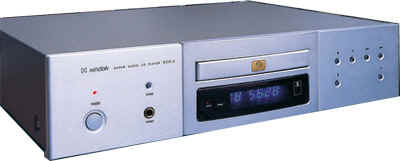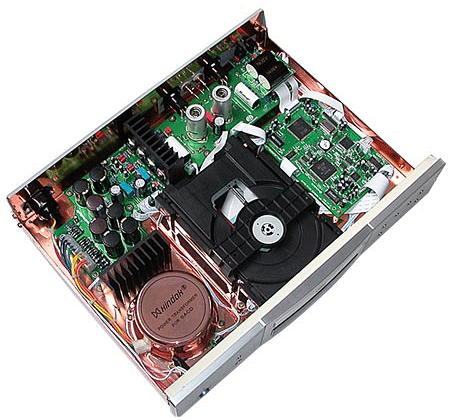You are reading the older HTML site
Positive Feedback ISSUE 9
october/november 2003
xindak
SCD-2 SACD/CD player
as reviewed by Robert H. Levi

ROBERT H. LEVI'S SYSTEM LOUDSPEAKERS ELECTRONICS SOURCES CABLES ACCESSORIES
|
Chengdu Xindak Electronics is not a well-known company on these shores, but it has been a big shot in China and the Far East marketplace since the late 80s, making amps, preamps, and DACs. The SCD-2, their first SACD/CD player, was released in 2002 for worldwide sale. It utilizes Burr Brown chips and a Who’s Who list of top capacitors and copper shielding. It weighs a hefty 16 pounds, and uses a Sony mechanism and other key Sony components. This company idolizes Sony and its SCD-1, calling it the "flower of Japan." Consequently, Xindak’s unit may be considered by some to be the Chinese tubed version of the Sony unit. It sounds a lot like it, and is a bargain in today’s crowded market.
The Xindak has a tubed output stage that contains two triodes, either 6N3s or 5670s. I don’t know anything about these tubes, other than that they have nine pins and are not interchangeable with each other. Confucious probably did their Website, while an out-of-work English translator did the manual. The fit and finish of the unit is very good, though the styling is rather ordinary. The remote is nicely done and logical, but I discovered that it only works with Eveready batteries, not Duracells or the supplied brand.
The unit features remote volume control, which works flawlessly and affects only the analog output. It may drive an amp (the manual is rather vague on this point), but with my 600-watt monoblocks, I did not have the guts to try direct connection. It cues up in about ten seconds—a nice feature. The single-ended outputs sound very, very close to the balanced outs, but the dynamics are slightly better through the balanced. All auditioning was done balanced. It has all the usual outputs on the rear, including both RCAs and XLRs, and a detachable power cord.
The Xindak is very power cord sensitive. Its character virtually becomes the power cord. Throw away the supplied cord and forget about garden-variety models—this unit needs an upmarket cord to sound its best. I got wonderful results from the Tara RSC Air 1 cord ($700 for 6 feet), which beat the Soundstring, Palladian. Decade, Tiff, and Belden 14-gauge cords I tried. We are therefore talking $1695 for the unit and $700 for the power cord, for a total investment of $2395. The Sony SCD-1 is discounted these days for about $2800. Both units have only two-channel outputs, no surround capability, and CD playback.
The Xindak requires considerable warm-up time, say three to four hours, so you
need to turn it on well in advance of listening. If it sounds dead and dull, it’s not
ready to go. But when it is ready, then SACD sound on the Xindak is gorgeous, textured,
rich, very ambient, and enhanced with a huge soundstage. It sounds almost like a tubed
version of the Sony SCD-1—amazingly close, in fact. The smooth warmth of tubes
replaces the crisp, incisive, solid state sound of the Sony. It gives up a tiny bit of
definition in the midrange in exchange for the added liquidity, but not much. It warms the
ambient textures of the highs and super highs, darkening them slightly, but again not
much.  The strings on
Telarc Hovhaness SACD flow invitingly on the Xindak, compared to the more rosiny sound on
the Sony. The Turina Telarc SACD rocks the room realistically on the Xindak, more vividly
on the Sony. The Carmina Burana Telarc SACD has vocals pinpointed in space, with
realistic, warm texture, though the Sony sounded airier and more you-are-there. The
Rebecca Pidgeon SACD on Chesky was interpreted by the Xindak as a very pleasing recital in
a small venue, while the Sony put me in a less inviting studio space. Duke
Ellington’s Blues in Orbit SACD on MoFi had the closest sound to an analog LP
yet on a digital medium. The Sony was more detailed front to back, and smooth, rather than
warm and sweet like the Xindak.
The strings on
Telarc Hovhaness SACD flow invitingly on the Xindak, compared to the more rosiny sound on
the Sony. The Turina Telarc SACD rocks the room realistically on the Xindak, more vividly
on the Sony. The Carmina Burana Telarc SACD has vocals pinpointed in space, with
realistic, warm texture, though the Sony sounded airier and more you-are-there. The
Rebecca Pidgeon SACD on Chesky was interpreted by the Xindak as a very pleasing recital in
a small venue, while the Sony put me in a less inviting studio space. Duke
Ellington’s Blues in Orbit SACD on MoFi had the closest sound to an analog LP
yet on a digital medium. The Sony was more detailed front to back, and smooth, rather than
warm and sweet like the Xindak.
The only time the Xindak was not competitive with the Sony was on mid/deep bass. The Dupre Telarc SACD was less detailed on the low organ notes and slightly blurred by the Xindak on crescendos. Not on the Sony. The Telarc SuperBass2 SACD was rather fat and tubby on the Xindak, more detailed and natural on the Sony. The Xindak had a tough time with bass fiddles, tubas, organs, and the like—not bad, mind you, but it’s hard to forget that tubes are in the output. If you prefer tube-like sound, you won’t be disappointed, but if your speakers have pronounced bass response, the Xindak may not be your best choice.
CD sound was, again, very lovely, and quite close to the SACD sound. It was subjectively better than the Sony in texture, and close to the Theta Gen.5a in overall presentation. The Theta has similar midrange characteristics, better bass, and bigger soundstaging. The Xindak is a winner with CDs, beating out players under $2500. It makes CDs more musical, a very fine attribute if you have a big CD collection. I very much enjoyed The Lauridsen Lux Aeterna CD on the Xindak. I do not know of a CD player more musical and listenable in this price range.
Treat the Xindak like a musical instrument, not a piece of electronics. Feed it a top power cord and interconnects (the Soundstrings and Kimber Selects were both terrific), and put it on a stable, vibration-free platform. I liked the balanced outputs best, with the gain at zero. Let it warm up for a few hours before each use, and you won’t be disappointed. It will embody the delicate and the powerful, with definition and musicality that rivals much more expensive units. If you have the budget for it, and have quality cables in house, this is THE tubed SACD player of choice. Spend $1695 and use the change for software. It’s more than a grand less than the current Sony ES 777, which has more features, but only marginally better sound. The Xindak makes SACDs and CDs sound superior to the omni players flooding the market. It’s all about the sound, and the Xindak SCD-2 sound is a winner. I strongly recommend it. Robert H. Levi

Xindak
SCD-2 SACD/CD player
Retail: $1695
Chengdu Xindak Electronics Co., Ltd.
web address: www.xindakaudio.com
US Distributor
J. C. Bertrand Audio
TEL: 603. 883. 1982
web address: www.bertrandaudio.com
